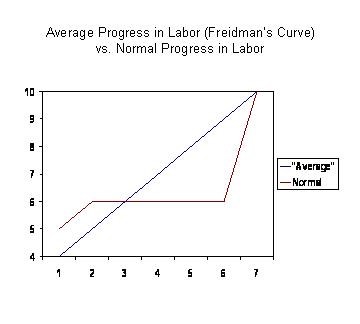Failing to Progress in Labor?

More than 1/3rd of unplanned c-sections that occur in the United States are due to women “Failing to Progress” during their labor.
This statistic is upsetting.
If mothers were properly educated on labor, birth, and their rights during the entire process, the statistic would be drastically lower. A failure to progress generally means a failure to wait, a failure to allow the woman’s body to work, and a failure to let a woman own her body. But again, most birthing women are not educated enough to understand that failing to progress is not failing, it is a plateau.
A plateau during labor occurs to naturally align baby and ensure that both mother and baby are prepared to welcome baby earthside. The length of this plateau can lasts minutes, hours, or even days if it occurs in early labor. And while that does not sound desirable, it is the way the body is built to handle labor, and it is the absolute safest and best way to let baby enter the world.
Most doctors will decide that a mother is not progressing well enough when labor lasts for approximately 20 hours or more if you are a first-time mother, and 14 hours or more if you have previously given birth. If you reach the pushing stage, a doctor will typically say that baby is too big to come on his own if you have pushed for 3 hours.
Please keep in mind that the average natural labor lasts 15-17 hours.
By avoiding cervical exams all together, you will never be aware of your plateau. But our society has defined labor as dilating a certain amount over a certain period of time, so not meeting this standard deems you a failure… and in come the interventions.
These interventions can include any or all of the following, along with other interventions: an amniotomy (intentional rupture of the bag of waters), augmentation of labor with Pitocin, an Epidural to take of the edge of Pitocin-induced contractions, and a Cesarean Section. All of which should be avoided.
Note: You can deny any and all cervical checks during labor, no matter where you are birthing.
A cesarean may also be suggested if the care team suspects that the baby may not fit through mom's pelvis. Diagnosed as "CPD", (this is the subject for another post altogether) but cannot be confirmed until baby is in the birth canal and has spent more than a handful of hours trying to be pushed out. There are rare cases when baby is stuck and cannot be moved – rare cases. If you believe this is happening during your labor, a doula will be your best friend, as she knows the positions to move you in to – the tricks of the trade to aid baby and mother to birth in the best position possible.
She will also be helpful in discussing options if baby does not move. Again, it can take hours – or days for the shift to occur.
I want to stress that a plateau in labor is very different than a 'Stalled Labor.' Stalling means that the labor has actually stopped for a long period of time (also normal). A plateau means that contractions are still occurring but there is no change is dilations, effacement, or station of baby. There are several reasons the body enters the plateau, the most important reason being that it is just a natural part of labor!
Most Common Reasons for a Plateau:
Baby’s Position, Better Alignment.
Whether “Sunny-Side Up” (OP position, baby looking toward the front instead of back of mom as he descends the birth canal), a hand in an awkward place, or just misaligned, the baby must find the best way through this narrow passage.
Softening of Cartilage.
The mother’s pelvis softens as it opens and the surrounding ligaments and tendons become more flexible as baby descends. This may take a prolonged period of time, but can be aided with different positions and patience.
Nervous System Massage.
Contractions may not be comfortable for the mother, but they act as a massage to the baby. This massage stimulates the nervous system and prepares it for our world.
Lung Stimulation.
The same massage that is activating the nervous system is also providing stimulation to the baby’s lungs. Each contraction squeezes and prepares the lungs to breathe oxygen for the first time.
Breastmilk Antibodies.
The breasts form all immunities necessary to protect the baby after birth while the mother is in labor. Sometimes, the breasts need more time to produce these antibodies. The process should not be rushed.
Mother’s Psychological Baggage.
Emotions, fears, a previous argument, anxiety, or anything consuming the back of the mother’s mind may actually be lengthening her labor. Letting go and giving into labor will allow the mother peace and the birth to progress quicker. Psychological changes in baby. Much research leads us to believe that the baby is going through psychological and emotional changes during labor. Some babies need more time to process that they are being born than others.
Things to Keep In Mind About Labor:
Changing location can trigger plateau.
Moving from home to a car to a hospital may cause the plateau to occur. Remember that the breasts produce antibodies for the environment a mother is in; if she is changing environments, the breasts need more time.
Dilation means nothing, the urge to push means everything.
A woman can be at 2 cm for 12 hours of labor and dilate from 2-10cm in hour 13, giving birth shortly afterward. A woman may plateau at 8cm for 8 hours and be ready to give up when the urge to push overwhelms her in that 9th hour. Every woman, every baby and every birth is different.
Lying on your back is counter-productive.
Gravity is your friend, work with it! Lying flat on your back prevents the contractions from allowing the uterus to completely align with the birth canal. So the body must produce 2 more intense contractions for every 1 it would need in a better position.
Education is the key.
Taking the time to be educated as the birthing mother – AND – the partner allows you the knowledge to understand your own labor. Hiring a doula is also a wise choice. Doctors have a hard time convincing couples to allow interventions who understand the birthing process.
Induction and medical interventions typically lead to true “Failure to Progress,” but not because the baby is stuck; instead because the baby was not ready to be born yet.
You read that correctly. Just because the date on the calendar says baby is ready, it does NOT mean that your baby is actually ready. By allowing your labor to be induced (medically triggered) or medically altered (sped up through medication) you increase the risk of labor not going as smoothly as you may have hoped. Increased interventions increase the risk of c-section rates by over 50%.
Please consider taking a natural childbirth class to educate yourself (and your partner) on labor.
Reference: The Bradley Method of Natural Childbirth
The content of this website, such as copy, images, graphics and any other material contained on this website ("Content") is for informational purposes only and does not constitute medical advice; the Content is not intended to be a substitute for professional medical advice, diagnosis, or treatment. Always seek the advice of a physician or other qualified health provider with any questions you may have regarding any medical condition. Never disregard professional medical advice or delay in seeking it because of something you have read on this website. In the event of a medical emergency, call your doctor or 911 immediately. This website does not recommend or endorse any specific tests, physicians, procedures, opinions, or other information that may be mentioned on this site. Reliance on any information provided by this website is solely at your own risk.








